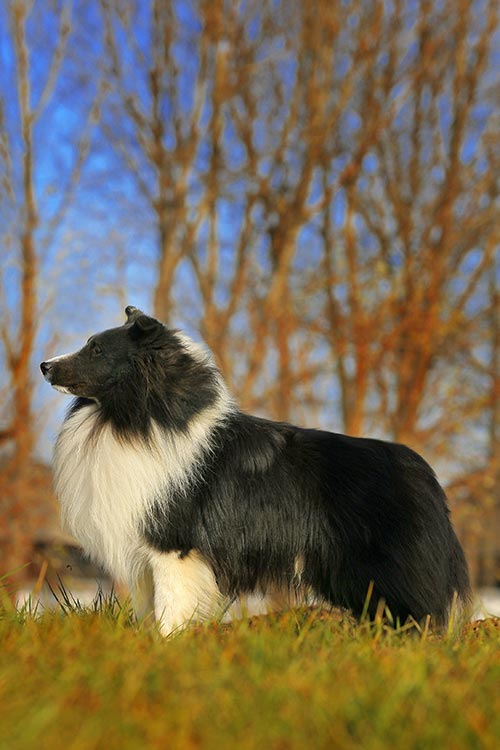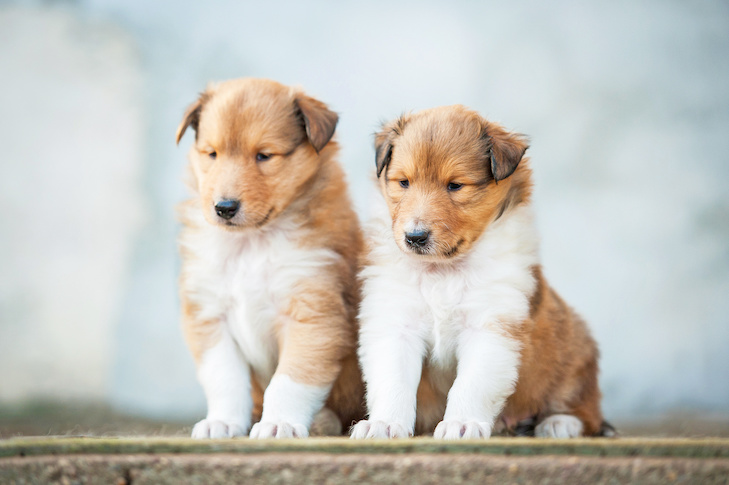
For decades, Lassie has been the star of books, movies, and television shows. This brave and intelligent dog character is a rough-coated Collie, and her incredible personality mirrors the breed’s typical characteristics. Thanks to Lassie, Collies are beloved and admired. They are also effortlessly recognizable. But did you know there’s a similar breed often mistaken for a Collie? The Shetland Sheepdog, or Sheltie, is a distinct breed, not a miniature Collie. Read on to learn how to tell these two whip-smart and equally beautiful breeds apart.
More Than a Toy Collie
Patt Caldwell, who has been a member of the Collie Club of America since 1975 and chairperson for the club’s Breed Education Committee for 14 years, says people frequently confuse the two breeds. “People will often erroneously call a Sheltie a ‘miniature Collie’ or a ‘toy Collie.’ It is neither. The Shetland Sheepdog is a separate, distinctive breed.”
However, she believes the dogs share many similarities, from their appearance to their personalities and heritage. “Both breeds are alert herding dogs, developed to protect and care for farm and field animals. They are double-coated dogs with similar coat texture; thus, their coat care is similar. Both breeds are highly intelligent and are cherished as family companions.”
Greg Speeks, breeder of Shetland Sheepdogs for 37 years and current president of the American Shetland Sheepdog Association, agrees with Caldwell that the two breeds have a lot in common which can confuse people. “Most often the Shetland Sheepdog is mistaken for a Collie, or they are referred to as a miniature Collie.”
The confusion stems from the strong resemblance each breed has to the other. As Speeks explains, “The Shetland Sheepdog breed standard states the Shetland Sheepdog bears the same relationship in size and general appearance to the rough Collie as the Shetland Pony does to some of the larger breeds of horses. Both breeds have similar coat type and come in a variety of the same colors. Both are herding breeds and can excel in a variety of events such as conformation, performance, or therapy. Both can be excellent companions and loving family members.”
- Collie
- Shetland Sheepdog
Physical and Personality Differences
The most obvious difference between the two breeds is size. According to the Collie breed standard, female Collies are 22-24 inches at the shoulders and males are 24-26. In contrast, Shelties of either sex stand 13-16 inches at the shoulders. So, it’s no surprise they differ in weight as well. The smaller Sheltie weighs between 15 and 25 pounds to the Collie’s 50-65 pounds for females and 60-75 pounds for males. Speeks believes the Sheltie’s smaller size may be a benefit for those living in urban areas.
Caldwell points out the two breeds have other physical differences too, such as eye shape, eye placement, and the stop (where the muzzle meets the forehead). But it doesn’t end there – the two dogs have distinct temperaments as well. “While Shelties bond to and are very devoted to their family, a Sheltie is often reserved with strangers. A Sheltie will size up the situation while a Collie is inclined to approach it.”
- Smooth-coated Collie
- Shetland Sheepdog
Shared Herding History
According to Caldwell, the Collie was developed to be a working/herding dog in Scotland, Ireland, and England. Their value came to light during the 16th century when sheep and cattle were an extensive part of the economy. “The prominence of the wool industry necessitated an agile dog that was versatile in its abilities to keep flighty sheep calm and under control. Likewise, cattle presented the need for a dog that could be bold enough to shepherd stubborn cattle that could also be easily spooked. The dog’s ability to read the sheep and cattle, respond immediately to their master’s commands, and think for themselves, made the Collie a valuable asset.”
The two varieties of Collie, the rough coated and the smooth, are a result of where the dogs were traditionally used. Caldwell clarifies, “The rough Collie was used more extensively for working in the fields and pastures while the short-coated smooth was developed to work rougher areas of the countryside and to drive sheep and cattle to market. Here a short coat needed less care.”
The Shetland Sheepdog shares the Collie’s herding origins, and their purpose is right in their name. Speeks explains that early Shelties were used to work Shetland sheep, a small and agile breed of sheep. “The Sheltie is a relatively new breed when compared to others. The breed originated in the Shetland Islands, which were remote and sparsely inhabited. Animals living there had to be hardy due to the windblown climate and little vegetation.”
- Collie puppies
- Shetland Sheepdog puppies sitting on a wood pile outdoors.
Intelligent and Dedicated Companions
Speeks believes most Sheltie owners would say the definitive characteristics of the breed include their beauty, brains, and loyalty. He says, “While personalities in Shelties can vary just like people, most are loyal, loving, highly intelligent, and often energetic. Shelties are kind and aim to please. They are not an aggressive breed. Sharing your life with a Sheltie is like living with your best friend. They understand you, love you regardless of your mood, and are always happy to see you.”
According to Caldwell, the defining qualities of the Collie are their intelligent curiosity and their concern for their human family’s emotions and needs. She describes them as intuitive, gentle, and affectionate companions. “Collies are exceptional canine family members. They have a pleasant, easy-going personality and are pleasers. Collies train easily and have a sense of humor. Often, they will repeat an action that has caused you to laugh, or they will look right into your face and wag their tail wildly with a seemingly doggy smile on their face.”
Both these attractive herders would make a loyal addition to your family. They’re great with children and easily trained. Just be prepared to provide plenty of mental and physical exercise. Whether you bring one of these breeds into your home, or simply meet them on the street, now you can appreciate the difference between Collies, the real-life Lassies, and their smaller cousins, Shelties.







